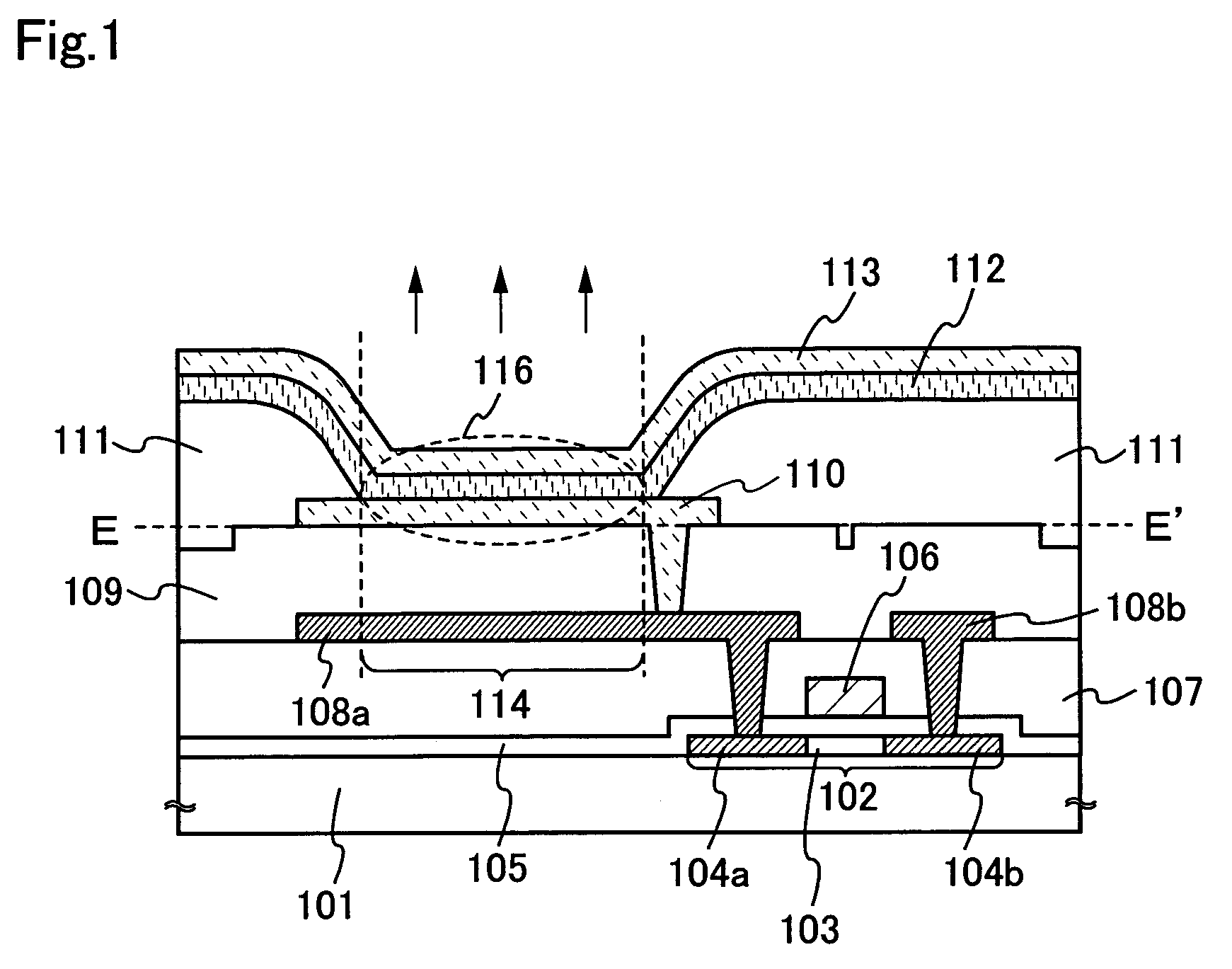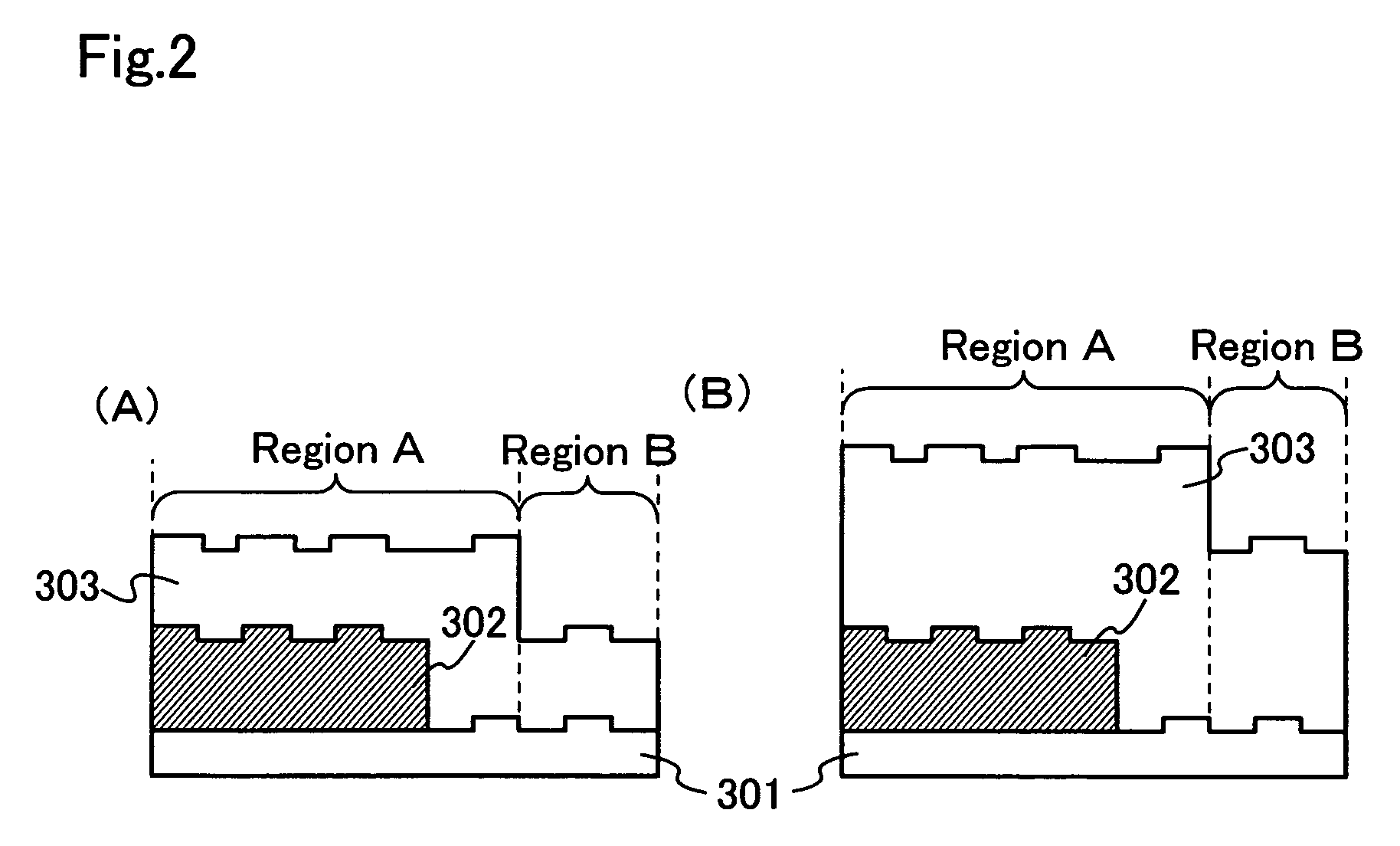Light emitting structure including an exposed electrode overlapping a wiring or conductive layer
a light emitting structure and exposed electrode technology, applied in the direction of electroluminescent light sources, identification means, instruments, etc., can solve the problems of low heat resistance of films with self-planarization, degradation of el elements, and inability to self-planarize, so as to improve the yield of the product, reduce the generation of trouble in the planarizing process, and facilitate the planarizing process
- Summary
- Abstract
- Description
- Claims
- Application Information
AI Technical Summary
Benefits of technology
Problems solved by technology
Method used
Image
Examples
embodiment mode 1
(Embodiment Mode 1)
[0044]A light-emitting device according to the present invention will be described with reference to FIG. 1.
[0045]FIG. 1 is a sectional view of a light-emitting device according to the present invention. In FIG. 1, a TFT 102 for driving a light-emitting element comprising a semiconductor film that has a source (or a drain) 104a and 104b, a gate insulating film 105, and a gate electrode (a gate wiring) 106 is formed on a substrate 101. The source (or the drain) 104a of the TFT for driving the light-emitting element is connected to a wiring 108a through a contact hole provided in a first interlayer insulating film 107. The first interlayer insulating film has a surface wholly planarized.
[0046]A second insulating film 109 is formed on the first interlayer insulating film 107 and wirings 108 (108a and 108b), and the wiring 108a is connected to an electrode 110 of the light-emitting element through a contact hole provided in the second insulating film 109. While a port...
embodiment mode 2
(Embodiment Mode 2)
[0055]In the present embodiment mode, a method of manufacturing a light-emitting device that has the structure shown in FIG. 1 will be described with reference to FIGS. 4 and 5 of sectional views of a process.
[0056]The structure of a TFT for driving a light-emitting element is not particularly limited, and a known structure may be used. For example, a top-gate TFT as shown in FIG. 1 may be employed or a bottom-gate TFT may be employed. Further, a TFT that has a single-gate structure may be employed or a TFT that has a multi-gate structure may be employed. Furthermore, a TFT that has an LDD (Lightly Doped Drain) structure may be employed and a TFT that has a single-drain structure may be employed. Besides, concerning crystallinity of the semiconductor film, an amorphous semiconductor film may be employed or a crystalline semiconductor film may be employed. In this way, as long as a thin film transistor includes a semiconductor film, a gate insulating film, and a ga...
embodiments
Embodiment 1
[0071]By applying the present invention, a film thickness to be deposited and an amount to be polished can be reduced in a planarizing process to make planarization easier.
[0072]A method of manufacturing a light-emitting device, to which the present invention is applied, will be described with reference to a top view in FIG. 3 and sectional views of processes in FIGS. 6 to 11.
[0073]FIG. 3 shows a top view of a pixel portion of a light-emitting device to which the present invention is applied. In FIG. 3, a semiconductor film 401a is a semiconductor film of a thin film transistor (TFT) for driving a light-emitting element, and the semiconductor film 401a has a source (or a drain) connected to a wiring 403a through a contact hole in a region surrounded by a dotted line 406. The wiring 403a is also connected to an electrode 404 of the light-emitting element through a contact hole. In an opening of a third interlayer insulating film 405, a portion in which the wiring 403a and...
PUM
 Login to View More
Login to View More Abstract
Description
Claims
Application Information
 Login to View More
Login to View More - R&D
- Intellectual Property
- Life Sciences
- Materials
- Tech Scout
- Unparalleled Data Quality
- Higher Quality Content
- 60% Fewer Hallucinations
Browse by: Latest US Patents, China's latest patents, Technical Efficacy Thesaurus, Application Domain, Technology Topic, Popular Technical Reports.
© 2025 PatSnap. All rights reserved.Legal|Privacy policy|Modern Slavery Act Transparency Statement|Sitemap|About US| Contact US: help@patsnap.com



